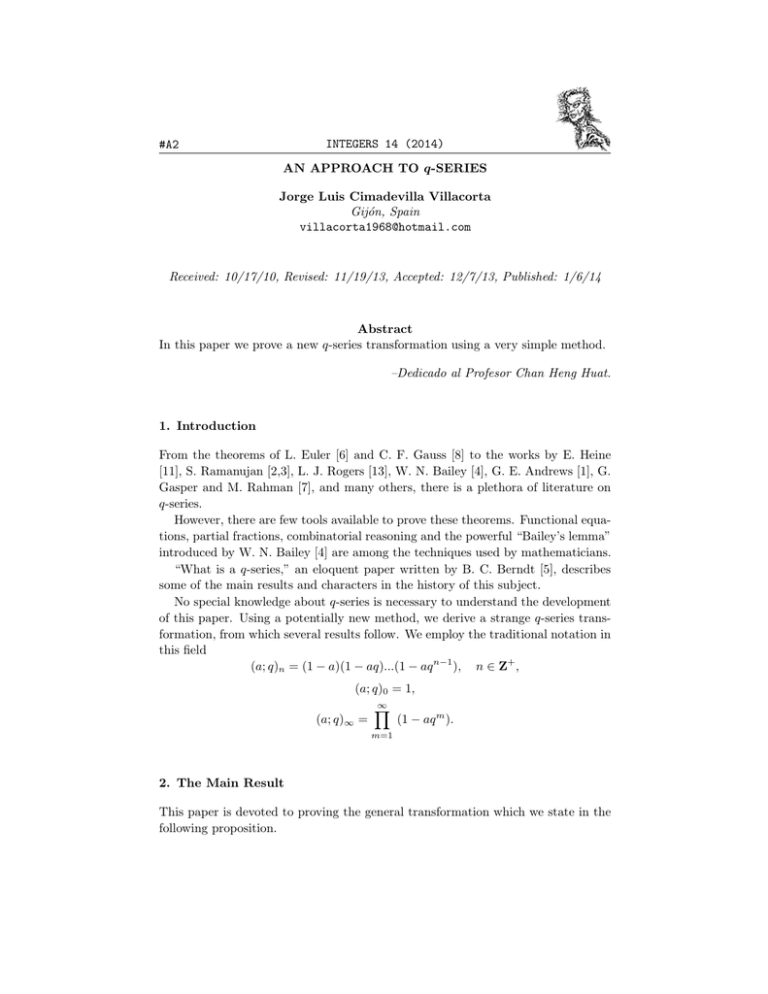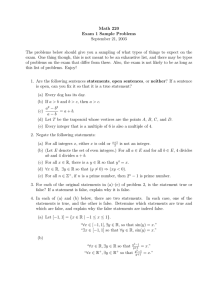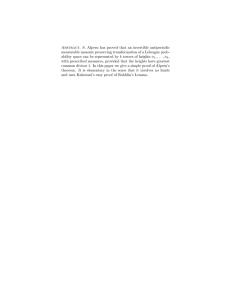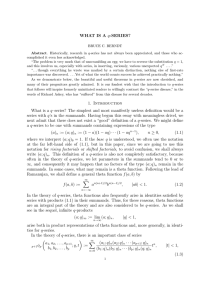#A2 INTEGERS 14 (2014) AN APPROACH TO q-SERIES Jorge Luis Cimadevilla Villacorta
advertisement

INTEGERS 14 (2014) #A2 AN APPROACH TO q-SERIES Jorge Luis Cimadevilla Villacorta Gijón, Spain villacorta1968@hotmail.com Received: 10/17/10, Revised: 11/19/13, Accepted: 12/7/13, Published: 1/6/14 Abstract In this paper we prove a new q-series transformation using a very simple method. –Dedicado al Profesor Chan Heng Huat. 1. Introduction From the theorems of L. Euler [6] and C. F. Gauss [8] to the works by E. Heine [11], S. Ramanujan [2,3], L. J. Rogers [13], W. N. Bailey [4], G. E. Andrews [1], G. Gasper and M. Rahman [7], and many others, there is a plethora of literature on q-series. However, there are few tools available to prove these theorems. Functional equations, partial fractions, combinatorial reasoning and the powerful “Bailey’s lemma” introduced by W. N. Bailey [4] are among the techniques used by mathematicians. “What is a q-series,” an eloquent paper written by B. C. Berndt [5], describes some of the main results and characters in the history of this subject. No special knowledge about q-series is necessary to understand the development of this paper. Using a potentially new method, we derive a strange q-series transformation, from which several results follow. We employ the traditional notation in this field (a; q)n = (1 a)(1 aq)...(1 aq n 1 ), n 2 Z+ , (a; q)0 = 1, (a; q)1 = 1 Y (1 aq m ). m=1 2. The Main Result This paper is devoted to proving the general transformation which we state in the following proposition. 2 INTEGERS: 14 (2014) Proposition 1. Let am (q) and bm (q), m 2 Z+ , be rational functions of q where |q| < 1 and |z| < 1. If 1 X m=0 am (q)y m = (yq 2 ; q 2 )1 1 X bm (q)y m , (1) m=0 then 1 1 (q; q)1 X (q 2 ; q 2 )1 X bm (q)( z; q)m + 2z 2 2 am (q)q m (z 2 ; q 2 )m ( z, q)1 m=0 (z , q )1 m=0 = 1 (q; q)1 X bm (q)(z; q)m . (2) (z, q)1 m=0 3. A Pair of Lemmas Before proving Proposition 1 we establish several lemmas. Lemma 2. Let |q| < 1 and |z| < 1. Then 1 X ( 1)m q (q; q)m (1 m=0 m2 +m 2 zq m ) = (q; q)1 . (z; q)1 Proof. We need only to rewrite the last expression as 1 X ( 1)m q (q; q)m (1 m=0 m2 +m 2 zq m ) = 1 X (q m+1 ; q)1 z m = (q; q)1 m=0 To do so, we use two results by Euler [6] 1 X zm 1 = (q; q)m (z; q)1 m=0 and 2 m m 1 X ( z)m q 2 = (z; q)1 . (q; q)m m=0 1 X zm (q; q)1 = . (q; q)m (z; q)1 m=0 (3) 3 INTEGERS: 14 (2014) Lemma 3. Let |q| < 1 and |z| <1. Then 1 X (n n X 1 ( 1)n i q ( 1 zq n i=0 (q; q)n n=0 i)2 +n 2 i bi (q)) = i 1 (q; q)1 X bn (q)(z; q)n , (z; q)1 n=0 (4) Proof. The infinite double series 1 X 2 1 X m +m 1 X ( 1)m q 2 (q; q)1 bn (q) = bn (q) n m+n ) (q; q) (1 zq (zq ; q)1 m n=0 m=0 n=0 can be rewritten in the more appropriate form 2 1 X (n i) +(n n X 2 1 ( 1)n i q ( bi (q) n 1 zq i=0 (q; q)n i n=0 i) )= 1 (q; q)1 X bn (q)(z; q)n . (z; q)1 n=0 4. An Additional Lemma and an Important Result In the following section we establish an additional lemma and highlight an important result used in its proof. Lemma 4. Let |q| < 1 and |z| < 1. Then 1 X n=0 1 n X qn ( 1)n i ai (q)q (n ( (q 2 ; q 2 )n i z 2 q 2n i=0 i)2 )= 1 (q 2 ; q 2 )1 X an (q)q n (z 2 ; q 2 )n . (z 2 ; q 2 )1 n=0 Proof. In this case, we begin with the double series 1 X n=0 2 1 2 2 X ( 1)m q m +m n (q ; q )1 ) = a (q)q , n (q 2 ; q 2 )n (1 z 2 q 2m+2n ) (z 2 q 2n ; q 2 )1 m=0 n=0 an (q)q n ( 1 X We can then rewrite the last identity as we did in (4). Now we can multiply (8) by (yq; q 2 )1 to find 2 (yq; q )1 1 X m=0 am (q)y m = (yq; q)1 1 X m=0 bm (q)y m . (5) 4 INTEGERS: 14 (2014) Equating coefficients of y n on both sides, we have n X ( 1)n i ai (q)q (n (q 2 ; q 2 )n i i=0 i)2 2 (n i) +(n n X 2 ( 1)n i bi (q)q = (q; q)n i i=0 i) . (6) Therefore we can substitute the right side of (6) into the left-hand side of (4) to obtain the important result mentioned earlier 1 X (n n X 1 ( 1)n i q ( 1 zq n i=0 (q; q)n n=0 i)2 +n 2 i i bi (q)) = 1 X n X 1 ( 1)n i ai (q)q (n ( n 1 zq i=0 (q 2 ; q 2 )n i n=0 = i)2 ) 1 (q; q)1 X bn (q)(z; q)n . (7) (z; q)1 n=0 5. Proof of the Main Identity We first restate the main identity of the paper before providing a proof. Proposition 1. Let am (q) and bm (q), m 2 Z+ , be rational functions of q where |q| < 1 and |z| < 1. If 1 X m=0 am (q)y m = (yq 2 ; q 2 )1 1 X bm (q)y m , (8) m=0 then 1 1 (q; q)1 X (q 2 ; q 2 )1 X bm (q)( z; q)m + 2z 2 2 am (q)q m (z 2 ; q 2 )m ( z, q)1 m=0 (z , q )1 m=0 = Proof. We only need to replace z with both identities: 1 (q; q)1 X bm (q)(z; q)m . (9) (z, q)1 m=0 z in (7), multipy (5) by 2z, and then add 1 1 1 (q 2 ; q 2 )1 X 1 (q; q)1 X 1 (q; q)1 X bn (q)(z; q)n + bn (q)( z; q)n + z an (q)q n (z 2 ; q 2 )n 2 (z; q)1 n=0 2 ( z; q)1 n=0 (z 2 ; q 2 ) n=0 = 1 X n X 1 ( 1)n i ai (q)q (n ( 1 zq n i=0 (q 2 ; q 2 )n i n=0 i)2 )= 1 (q; q)1 X bn (q)(z; q)n . (z; q)1 n=0 5 INTEGERS: 14 (2014) 6. Applications and Examples Application 5: Mock theta functions. We take the product ( yq 2 ; q 2 )1 (yq 2 ; q 2 )1 = (y 2 q 4 ; q 4 )1 , where ( yq 2 ; q 2 )1 = and (y 2 q 4 ; q 4 )1 = 2 1 1 X X q n +n y n = bn (q)y n 2 ; q2 ) (q n n=0 n=0 2 1 1 X X ( 1)n q 2(n +n) y 2n = an (q)y n . 4 ; q4 ) (q n n=0 n=0 If we then insert an (q) and bn (q) from above into (9), we find 2 2 1 1 (q; q)1 X q n +n ( z; q)n (q 2 ; q 2 )1 X ( 1)n q 2(n +n) q 2n (z 2 ; q 2 )2n + 2z ( z; q)1 n=0 (q 2 ; q 2 )n (z 2 ; q 2 )1 m=0 (q 4 ; q 4 )n = 2 1 (q; q)1 X q n +n (z; q)n . (10) (z; q)1 n=0 (q 2 ; q 2 )n We now need the classical result of Rogers [13] 2 1 X 1 q n +n = . (q 2 ; q 5 )1 (q 3 ; q 5 )1 n=0 (q; q)n Thus, in (10) by replacing z with q, we finally obtain 2 1 1 X (q; q 5 )1 (q 4 ; q 5 )1 (q 5 ; q 5 )1 2X q n +n n 2(n+1)2 2 4 + ( 1) q (q ; q )n = . ( q; q)1 q n=0 ( q; q)n n=0 (11) This is a famous identity first proved by G. N. Watson [14] for the fifth order mock theta functions. Application 6: A New Result from a Classic Identity. choose 2 1 1 X X qm am (q)y m = ( yq; q 2 )1 = (q 2 ; q 2 )m m=0 m=0 and 1 X m=0 bm (q)y m = In this case we 1 1 2 X ( yq; q 2 )1 ; q )m m 2m ( q = y q . 2 2 2 (yq ; q )1 (q ; q 2 )m m=0 6 INTEGERS: 14 (2014) Inserting these results into (9) we find 2 1 1 (q, q)1 X 2m ( q 1 ; q 2 )m ( z; q)m (q 2 ; q 2 )1 X q m +m (z 2 ; q 2 )n q + 2z ( z; q)1 m=0 (q 2 ; q 2 )m (z 2 ; q 2 )1 m=0 (q 2 ; q 2 )m = 1 (q, q)1 X 2m ( q 1 ; q 2 )m (z; q)m q . (12) (z; q)1 m=0 (q 2 ; q 2 )m In the last identity V. A. Lebesgue’s [12] classic result appears: 2 1 X q m +m (z 2 ; q 2 )m = (z 2 q 2 ; q 4 )1 ( q 2 ; q 2 )1 . 2 ; q2 ) (q m m=0 Therefore we can rewrite (12) as 1 (q, q)1 X 2m ( q 1 ; q 2 )m ( z; q)m (q 4 ; q 4 )1 q + 2z ( z; q)1 m=0 (q 2 ; q 2 )m (z 2 ; q 4 )1 = 1 (q, q)1 X 2m ( q 1 ; q 2 )m (z; q)m q , (13) (z; q)1 m=0 (q 2 ; q 2 )m which appears to be a new result. Application 7: An Interesting Identity. In this example, we take 1 X am (q)y m=0 m 2 2 = (yq ; q )1 1 X 2 q m +m = ( 1) , (q 2 ; q 2 )m m=0 m where b0 = 1, b1 , b2 , b3 ... = 0. If we use these results in (9), we find 1 m2 +2m 2 2 (q; q)1 (q 2 ; q 2 )1 X (z ; q )m (q; q)1 mq + 2z 2 2 ( 1) = . ( z; q)1 (z ; q )1 m=0 (q 2 ; q 2 )m (z; q)1 (14) Using the previous identity, we can obtain the following interesting result. If 1 X 1 = cm q m (q; q 2 )1 m=0 then 1 X m=1 c2m m = (q 2 , q 2 )1 1q 1 X 2 ( 1)m m=0 q (m+1) (q; q 2 )m . (q 2 ; q 2 )m (15) 7 INTEGERS: 14 (2014) Another possibility is using the second Göllnitz-Gordon [9,10] identity 2 1 X q n +2n ( q; q 2 )n 1 = 3 8 2 , q2 ) 4 ; q 8 ) (q 5 ; q 8 ) (q (q ; q ) (q n 1 1 1 m=0 p q and z = i q. From this we obtain in (14) where q ! p 1 3 1 3 2i q (iq 2 ; q 2 )1 ( iq 2 ; q 2 )1 ( iq 2 ; q 2 )1 (iq 2 ; q 2 )1 + = . (q; q 2 )1 ( q 2 ; q 2 )1 (q 3 ; q 8 )1 (q 4 ; q 8 )1 (q 5 ; q 8 )1 (q; q 2 )1 ( q 2 ; q 2 )1 The following identity is equivalent. If ( q; q 2 )1 = then 1 X ( 1)m a2m+1 q m = m=0 1 X am q m , m=0 (q 1 ; q 8 )1 (q 7 ; q 8 )1 ( q 4 ; q 4 )1 . (q 2 ; q 4 )1 7. An Alternative Proof of the Main Identity G. E. Andrews graciously provided the author with the following alternative proof of identity (9): 1 1 (q; q)1 X (q; q)1 X bm (q)( z; q)m + bm (q)(z; q)m = ( z; q)1 m=0 (z; q)1 m=0 = (q; q)1 1 X m=0 = (q; q)1 1 X = 2(q; q)1 j=0 1 1 + ) ( zq m ; q)1 (zq m ; q)1 bm (q) m=0 = 2(q; q)1 1 X bm (q)( 1 X j=0 1 X z j q mj (( 1)j+1 + 1) (q; q)j j=0 1 z 2j+1 X bm (q)q m(2j+1) (q; q)2j+1 m=0 1 X z 2j+1 1 am (q)q m(2j+1) (q; q)2j+1 (q 2j+3 ; q 2 )1 m=0 1 1 (q; q)1 X z 2j+1 X =2 am (q)q m(2j+1) (q; q 2 )1 j=0 (q 2 ; q 2 )1 m=0 8 INTEGERS: 14 (2014) = 2(q 2 ; q 2 )1 = 2(q 2 ; q 2 )1 1 X 1 X zq m am (q) m=0 1 X z 2j q 2jm (q 2 ; q 2 )j j=0 1 zq m am (q) (q 2 ; q 2 )1 X m = 2 zq am (q)(z 2 ; q 2 )m . 2 q 2m ; q 2 ) 2 ; q2 ) (z (z 1 1 m=0 m=0 Acknowledgement. The author would like to thank George E. Andrews, Timothy Kehoe and Jack Rossbach for their contributions as well as their patience. References [1] Personal website of G. E. Andrews, available at www.math.psu.edu/andrews, Pennsylvania State University. [2] G. E. Andrews and B. C. Berndt, Ramanujan´s Lost Notebook, Part I, Springer, New York, 2005. [3] G. E. Andrews and B. C. Berndt, Ramanujan´s Lost Notebook, Part II, Springer, New York, 2009. [4] W. N. Bailey, A note on certain q-identities, Quart. J. Math. (Oxford) 19 (1941), 157-166. [5] B. C. Berndt, Ramanujan Rediscovered: Proceedings of a Conference on Elliptic Functions, Partitions and q-series in memory of K.Venkatachaliengar. Bangalore, 1-5 June, 2009. [6] L. Euler, Introductio in Analysin Infinitorum, Marcum-Michaelem Bousquet, Lausannae, 1748, 237-240. [7] G. Gasper and M. Rahman, Basic Hypergeometric Series, 2nd. ed., Cambridge University Press, Cambridge, 2004. [8] C. F. Gauss, Werke, Vol. 3, K. Gesell,Wiss., Göttingen, 1866. [9] H. Gollnitz, Partitionen mit Di↵erenzenbedingungen, J. Reine Angew. Math. 225 (1967), 154-190. [10] B. Gordon, Some continued fractions of the Rogers-Ramanujan type, Duke Math J. 32 (1965), 741-748. [11] E. Heine, Untersuchungen über die Reihe 1+ (1 q ↵ )(1 q ) (1 q ↵ )(1 q ↵+1 )(1 q )(1 q +1 ) 2 .x + .x + ..., (1 q)(1 q ) (1 q)(1 q 2 )(1 q )(1 q +1 ) J. Reine Angew. Math. 34 (1847), 285-328. [12] V. A. Lebesgue, Sommation de quelques series, J. Math. Pure. Appl. 5 (1840), 42-71. [13] L. J. Rogers, Second memoir on the expansion of certain infinite products, Proc. London. Math. Soc. 16 (1917), 315-336. [14] G. N. Watson, The mock theta functions (2), Proc. London Math. Soc. 42 (1937), 274-304.








